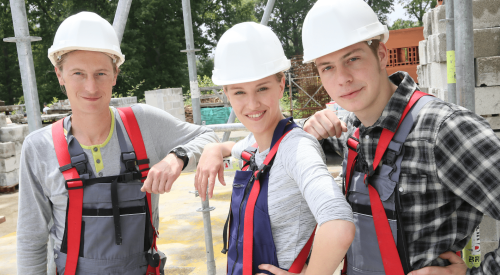Pro Builder’s Forty Under 40 celebration of young leaders presents the perfect opportunity to consider the importance of building the next generation of professionals who will power our industry.
The median age of a construction worker in the Unites States, at 41, is on par with the typical worker in the overall labor force. But in some areas of the country, including the Northeast, the median age of a construction worker is closer to 47. Nationally, more than 23% of the workforce is aged 55 or older.
A recent report from the Home Builders Institute (HBI), the educational arm of the National Association of Home Builders, projects residential construction will need 2.2 million new hires over the next three years to keep pace with growth and attrition. The skilled labor shortage is adding to construction delays and affecting housing affordability.
RELATED
- Building the Pipeline for Next-Gen Skilled Labor
- HBI President Ed Brady’s Call to Action to Solve the Construction Industry’s Labor Shortage
- North Carolina ‘Be Pro Be Proud’ Program Seeks to Boost Workforce Development
NAHB Initiatives to Develop Residential Construction's Workforce of the Future
NAHB recently launched two initiatives to help develop our industry’s future workforce. These efforts include an agreement with the Boys & Girls Clubs of America that gives the more than 4 million young people enrolled in those clubs an opportunity to learn about careers in residential construction. NAHB also announced its support of SkillsUSA, a national education nonprofit focused on workforce development. The sponsorship will support the group’s mission as well as scholarships for winners of a national carpentry competition.
Central to NAHB’s efforts, of course, is HBI, with its more than 500 programs in 47 states, which graduate roughly 10,000 students each year with skills in carpentry, electrical, plumbing, building construction technology, HVAC, landscaping, masonry, and solar installation. HBI’s new BuildStrong Academies are creating a nationwide network of home building training centers offering free tuition to anyone 18 or older interested in a career in the construction trades. BuildStrong Academies are now open in Denver, New Orleans, and Orlando, Fla., with others slated to open this year in Houston, Phoenix, Sacramento, Calif., and Charlotte, N.C.
We must forge partnerships, mentor young people, and broadcast the message that residential construction offers high-fulfillment jobs with strong earning potential.
NAHB’s philanthropic arm, the National Housing Endowment, is dedicated to developing the residential construction workforce through education, training, and research. The endowment supports construction management programs at colleges and universities as well as trades training programs in high schools and activities that introduce students at all levels to careers in home building.
We must reach out to teachers, school guidance counselors, parents, and others who influence middle and high school students to correct misconceptions about careers in construction and return hands-on skills training to our schools. We must forge partnerships, mentor young people, and broadcast the message that residential construction offers high-fulfillment jobs with strong earning potential.
Striving to Make Home Building and Industry Open to All
We also must persist in recruiting more women and minorities and training displaced workers and at-risk youth for these jobs. We’re making progress, with NAHB’s Student Chapters, Professional Women in Building Council, and Young Professionals group all working to attract members and encourage our increasingly diverse membership to connect, collaborate, and develop professionally within the association.
A new Emerging Professional level of membership bridges the gap for student chapter and HBI graduates to become NAHB members at a reduced rate, giving them the benefits of membership, at a discount.
Building homes for American families offers tremendous satisfaction and solid pay. The housing industry is hiring. Let’s reach out and invite more young people to be a part of it.
W2W4 at NAHB
NAHB supply chain resources
NAHB is working to help members navigate building material supply chain challenges, especially lumber. Economic analysis, talking points, and webinars are available at
nahb.org/supplychain
Educational programming
NAHB offers practical industry training, with dozens of courses and seminars for building professionals. Search the Education Calendar at nahb.org for upcoming local classes or to learn online at your own pace.













